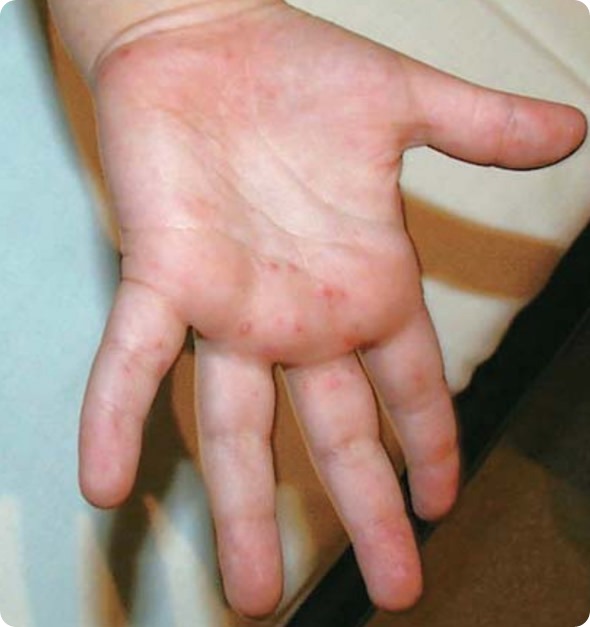Hand-foot-mouth disease is an infectious disease caused by a virus and it often affects the throat first.
What causes Hand, foot and mouth disease?
Hand-foot-and-mouth disease (HFMD) is commonly caused by coxsackie virus A16, a member of the enterovirus family.
In some cases can be caused by the coxsackie B or the enterovirus 71 virus.

Why is it called hand, foot and mouth disease?
Hand, foot and mouth disease gets its name from the non-itchy rash that develops on the palms of the hands and soles of feet.
HFMD is a different infection from the infection of cattle, sheep and pigs called foot-and-mouth disease. (1-5)
Where does hand, foot and mouth disease come from?
It does not come from pets but may spread from person to person through contact.
Contact with infected discharge of mucus from throat, nose, saliva and fluids from the ruptured blisters as well as infected faeces of the sufferer are often the cause of transmission of this infection. The first week of the infections is most contagious.
Who can catch hand, foot and mouth disease and when?
Once the infection is caught the time taken to develop symptoms may be between 3 to 7 days. This is called the incubation period.
Children are most susceptible to this infection. The most common age group of sufferers are children below 10 years.
Adolescents and occasionally adults may also acquire the infection.
Most adults are immune to the coxsackie A and B virus as they have been previously exposed to it during their childhood. Even if they acquire the infection, it tends to be milder than in children.
Summer and early fall is the common season for this infection. A child may get the infection more than once but usually does not get it twice in the same outbreak season.
Symptoms of hand, foot and mouth disease
Symptoms of HFMD include fever, headache and lack of appetite. There is intense sore throat and most patients develop a rash with very small blisters on hands, feet, and diaper area.
This rash is painful when pressed or touched. On examination tiny ulcers with red and raw edges are visible over throat, tongue, tonsils and mouth.
Diagnosis of hand, foot and mouth disease
Diagnosis is often made by the clinical presentation and findings. Laboratory diagnosis is seldom required.
There are clinically diagnostic blisters on the hands and feet that are important for diagnosis.
Therapy for hand, foot and mouth disease
This is a viral illness with no real specific therapy. Treatment is aimed at relief of symptoms.
Antibiotics are ineffective and are not recommended.
Acetaminophen and Ibuprofen may be prescribed for pain and fever.
Aspirin should be avoided in children below 12 years since in viral illnesses. Aspirin may lead to a life threatening liver and brain damage syndrome called Reye’s syndrome.
The patient is made to rinse and gargle with salt and warm water to soothe the throat. Plenty of fluids are advised especially if there is accompanying fever.
Acidic fluids like juice and sodas often burn the ulcers in the throat and may cause discomfort. Commonly advised fluids are water and cold milk products.
How long does hand, foot and mouth disease last?
It takes around 5 to 7 days for the infection to resolve completely. It often resolves by itself with no therapy.
There may be complications like dehydration, high fever and associated febrile seizures in young children and associated secondary or superimposed bacterial infections.
One complication is viral (aseptic) meningitis. This usually means an infection of the coverings of the brain. This may require the child to be hospitalized.
Prevention of hand, foot and mouth disease
Prevention of the illness usually means isolation of the infected child. Hand washing and general principles of hygiene also protect from the spread of the infection.
Further Reading